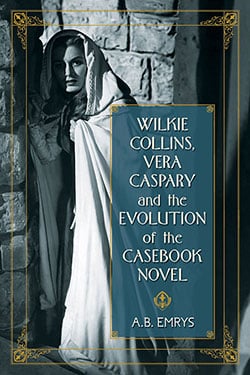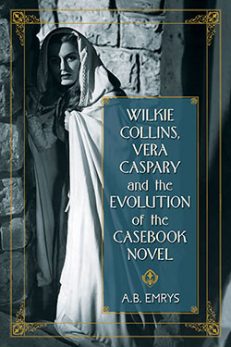Wilkie Collins, Vera Caspary and the Evolution of the Casebook Novel
$49.95
In stock
About the Book
Wilkie Collins was one of the most popular novelists during England’s Victorian era. While Collins scholarship has often focused on social issues, this critical study explores his formal ingenuity, particularly the novel of testimony constructed from epistolary fiction, trial reports and prose monologue. His innovations in form were later mirrored by Vera Caspary, who adapted The Woman in White three times into contemporary fiction. This text explores how the formal dialogue between Collins and Caspary has linked sensation fiction with noir thrillers and film noir.
About the Author(s)
Bibliographic Details
A.B. Emrys
Format: softcover (6 x 9)
Pages: 220
Bibliographic Info: bibliographies, index
Copyright Date: 2011
pISBN: 978-0-7864-4786-2
eISBN: 978-0-7864-8503-1
Imprint: McFarland
Table of Contents
Acknowledgments v
Introduction 1
1. Framed: A Brief History of Documents as Narrative Frames 9
2. How He Wrote His Books: The Apprentice Years of Framing Testimony 20
3. The Woman in White: Collins Launches the Casebook Novel 35
4. Counterpoint Witnessing in No Name and Armadale 47
5. The Moonstone: Collins Eclipses His First Casebook 59
6. Framed Testimony in Collins’s Later Novels 72
7. The Casebook After Collins 83
8. Before Laura: Vera Caspary’s Early Career and Novels 99
9. Laura: A Noir Novel Deeply Rooted in Sensation 111
10. Laura and Bedelia: “New Woman” Noir 127
11. After Laura: Caspary’s Other Casebook Novels 140
12. Caspary Continues to Apply Multiple Focus 153
13. Reframed: Multiple Focus in Popular and Literary Texts 168
Conclusion 188
Bibliography 199
Primary Collins Texts 199
Primary Caspary Texts 199
Other Primary Texts 201
Secondary Texts 203
Index 207
Book Reviews & Awards
- Finalist, Agatha Award—Malice Domestic Mystery Convention. Finalist, Macavity Award—Mystery Readers International
- “A clearly written scholarly trek over fresh critical ground…this is one of the year’s best books of mystery scholarship and deserves strong Edgar consideration”—Mystery Scene Magazine





